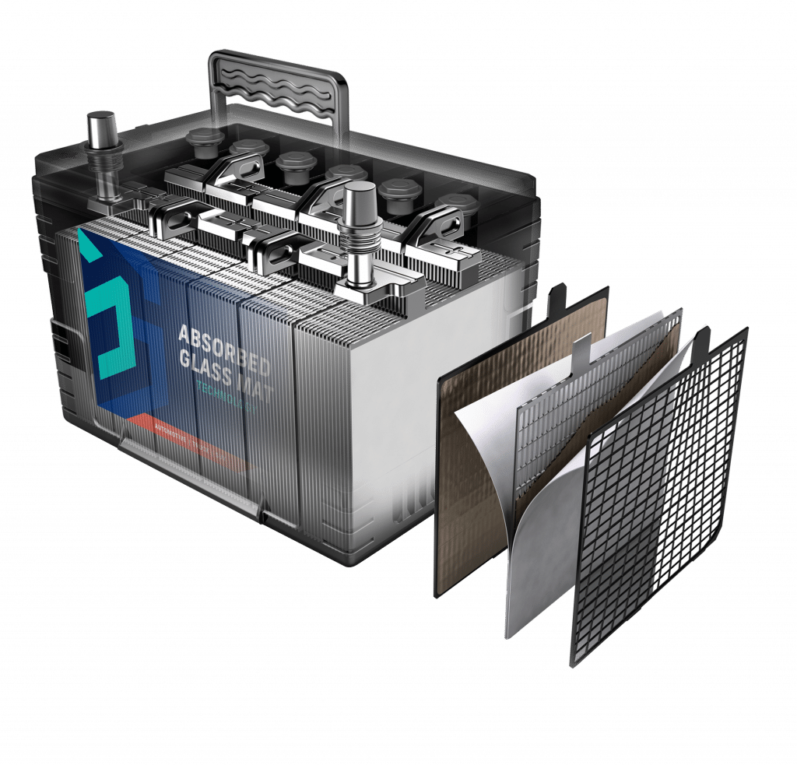An Absorbent Glass Mat (AGM) battery differs from a conventional flooded or wet cell lead-acid battery in its construction. In an AGM battery, the acid electrolyte is absorbed and held in place by glass mat separators between the lead plates rather than floating freely in liquid form.
This keeps the sulphuric acid immobilized within the battery but still allows it to flow easily between the lead plates during the charge and discharge process. The glass mats are designed as thin sheets of absorbent glass microfiber material that serves as a reservoir and conduit for the acid electrolyte.
During charging, the lead plates and absorbed acid react to form lead dioxide on the positive plates and spongy lead on the negative plates just as in a regular lead-acid battery. The glass mat separators prevent acid stratification and short-circuiting between the plates while still allowing for ion flow.
Key Benefits of AGM Batteries
Absorbent Glass Mat Battery offer various advantages due to their unique construction and immobilized electrolyte system:
– They can be mounted in any orientation including upside down without acid leaking or spilling. This makes them suitable for applications with limited space like motorcycles, boats, and vehicles.
– The sealed construction makes them virtually maintenance-free as the electrolyte cannot evaporate over time like in wet cell batteries. They do not require topping up with distilled water.
– The immobilized acid provides better vibration resistance and tolerance to shocks and impacts. This makes AGM batteries more durable than flooded batteries in vehicles.
– They have lower internal resistance and higher discharge rates allowing for higher cranking power, especially in cold weather conditions.
– AGM batteries can be discharged to lower levels than traditional lead-acid batteries without damage. This provides greater energy availability from the battery.
– Self-discharge rates are relatively low at around 3-5% per month, ensuring long shelf life and storage times.
– The sealed AGM construction makes them safer and more suitable for indoor/home applications compared to vented flooded batteries.
Applications of AGM Batteries
Due to their benefits over flooded lead-acid batteries, AGM batteries have found acceptance in the following key applications:
– Motorcycles and automotive starting, lighting, and ignition applications: Their shock and vibration tolerance along with positioning flexibility make them ideal for motorcycle batteries. Car AV systems also use AGM batteries.
– Marine applications: Their sealed construction preventing acid spills and ability to be mounted in any orientation is well-suited for rocking boat environments. Many pleasure crafts and RVs use AGM batteries.
– Uninterruptible power supply (UPS) systems: The stable voltage output and ability to deliver high currents even when partially drained is well-matched for backup power solutions.
– Telecom and alarm systems: Their maintenance-free operation and high shelf life allows reliable operation of telecom equipment located outdoors or remote sites. Burglar alarms also commonly use AGMs.
– Solar and off-grid energy storage: When paired with solar panels, AGM batteries provide stable reliable energy storage better than flooded lead-acid in off-grid homes, remote facilities, etc.
– Medical equipment: Features like non-spillability, low maintenance and stable operation make them suitable for powering medical devices used in ambulances, hospitals, etc.
Manufacturers and Trends
Some of the major manufacturers of AGM batteries globally include Crown Battery, Lifeline Batteries, EnerSys, East Penn Manufacturing, and Universal Power Group. These companies produce AGM batteries for a variety of applications under different brand names.
With the rising demand for sealed, maintenance-free batteries and the wide acceptance of AGM technology, manufacturers are developing advanced variants to deliver higher performance. These include gel batteries combining benefits of AGM and gel batteries, along with lightweight and high-power models for specialized uses.
New production technologies like advanced glass mat designs and alloys are also helping to boost AGM battery performance, power, and cycle life characteristics. Their adoption is projected to grow further in sectors like renewable energy storage, electric mobility, and telecom backup applications where low-cost sealed lead-acid remains important. With their ability to deliver reasonably high currents along with resistance to shocks and vibrations, AGMs have become a popular option across automotive, marine, and standby power applications.
Ongoing developments aim to further enhance their performance and lower costs. As such, AGM batteries hold promise to remain an important technology for diverse industrial and consumer energy storage needs in the future.
*Note:
1. Source: Coherent Market Insights, Public sources, Desk research
2. We have leveraged AI tools to mine information and compile it

